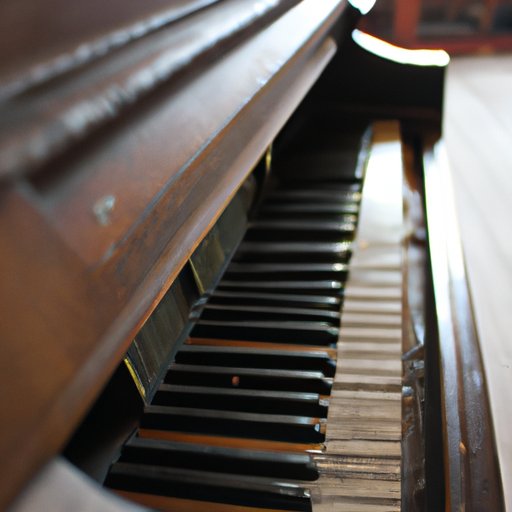Introduction
The piano is one of the most iconic musical instruments in the world. It is used by musicians, composers, and performers around the globe to create a variety of different styles of music. But who invented the piano? To answer this question, it is necessary to look at the life and work of Italian instrument maker Bartolomeo Cristofori and his groundbreaking invention.

Biographical Profile of Bartolomeo Cristofori
Bartolomeo Cristofori was born in Padua, Italy in 1655. He was trained as an organ builder by his father and eventually became the chief instrument maker for the Grand Prince Ferdinando de’ Medici of Tuscany. Throughout his career, he worked on a variety of stringed instruments such as harpsichords, clavichords, and organs. In 1700, he invented the piano and spent the remainder of his life perfecting his design. He died in 1731, leaving behind a legacy that would shape the future of music.
History of Keyboard Instruments
Keyboard instruments have been used since ancient times. Early keyboard instruments included the clavichord, which was popular during the Middle Ages and Renaissance periods, and the harpsichord, which was developed in the fifteenth century. These instruments were limited in their range and dynamics, as they did not allow for any variation in volume or tone. This posed a challenge for composers trying to create more expressive pieces of music.
Cristofori recognized this limitation and set out to create a new type of keyboard instrument. By combining the best features of the clavichord and the harpsichord, he created the piano. His invention allowed for greater control over the dynamic range and tonal qualities of the instrument, making it possible for composers to create more complex and expressive pieces of music.

Historical Context of the Invention of the Piano
In order to understand why Cristofori invented the piano, it is important to look at the historical context of the time. During the late seventeenth and early eighteenth centuries, Europe was experiencing a period of political and social change. This was especially true in Italy, where the country was divided into a number of small states ruled by powerful families.
At the same time, the economy was booming due to increased trade and the influx of wealth from overseas colonies. This economic prosperity enabled wealthy patrons to commission new musical instruments, which in turn encouraged instrument makers like Cristofori to experiment with different designs.
Analysis of the Design and Mechanics of the Piano
Cristofori’s design for the piano was based on two basic principles: the use of hammers to strike the strings, and the use of dampers to control the length of time the strings vibrate. The hammers are connected to the keys, so when a key is pressed down, the hammer strikes the string, producing a sound. The dampers are connected to the keys as well, so when a key is released, the damper stops the vibration of the string.
This ingenious design allowed for greater control over the dynamic range and tonal qualities of the instrument. The keys could be played softly or forcefully, allowing for subtle nuances in the music. Additionally, the dampers allowed for a sustained note, something that was not possible on the earlier keyboard instruments.

Impact of the Invention of the Piano
The invention of the piano had a profound impact on both music and culture. Composers were now able to compose more complex and expressive pieces of music, which helped to usher in a new era of classical music. This also had an effect on other musical styles such as jazz and rock, as composers began to incorporate elements of the piano into their music.
The piano also had a huge influence on the development of future musical instruments. Many of the techniques pioneered by Cristofori, such as the use of hammers and dampers, were applied to other instruments such as the organ, resulting in increased control over the dynamic range and tonal qualities of these instruments.
Conclusion
Bartolomeo Cristofori was an Italian instrument maker who revolutionized the world of music with his invention of the piano. His ingenious design, which combined the best features of the clavichord and the harpsichord, allowed for greater control over the dynamic range and tonal qualities of the instrument. This innovation had a profound impact on music and culture and paved the way for future musical innovations.
Although much has been written about the invention of the piano, there is still more to be discovered. Future research should explore the influence of political, social, and economic factors on the development of keyboard instruments, as well as the influence of the piano on other musical styles.
(Note: Is this article not meeting your expectations? Do you have knowledge or insights to share? Unlock new opportunities and expand your reach by joining our authors team. Click Registration to join us and share your expertise with our readers.)
